Dynamics of Air - 10 Kinds of Fog, airflows and air awareness
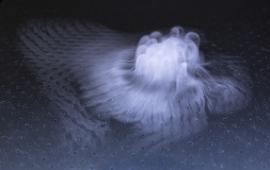
In Summary
- 10 Kinds of Fog, explores how the depthless, formless phenomena of fog can assume different and distinct qualities
- Make the Invisible Visible, displays different techniques for real-time visualisation of microclimates and airflow around surfaces
- Mini Interactive Wind Tunnel 2018 shows interactive computer simulations of wind that are often difficult to comprehend
Swinburne’s Dean of Design, Professor Jane Burry and Dr Malte Wagenfeld, Senior Lecturer in Industrial Design, RMIT University have collaborated to curate Dynamics of Air with commissioned works by artists, designers, architects and engineers to capture the aesthetic, technical and phenomenal qualities of air in architecture, space and the environment.
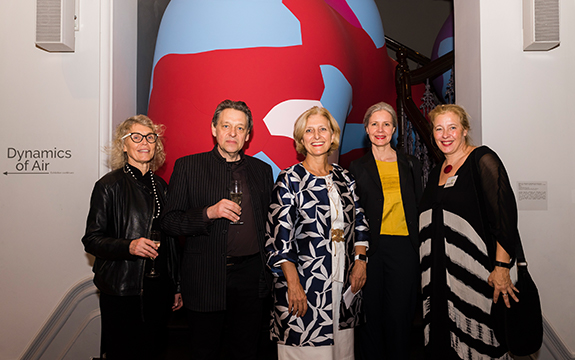 Professor Jane Burry, Dr Malte Wagenfeld, Dr Anna Prinz, German Ambassador to Australia, Sonja Griegoschewski, Goethe Institut Director, Gabriele Urban, Inflated Restraint by Phil Ayres in background. Photography by Mark Ashkanazy.
Professor Jane Burry, Dr Malte Wagenfeld, Dr Anna Prinz, German Ambassador to Australia, Sonja Griegoschewski, Goethe Institut Director, Gabriele Urban, Inflated Restraint by Phil Ayres in background. Photography by Mark Ashkanazy.
The Dynamics of Air exhibition included works by Swinburne academics and researchers - Associate Professor of Architecture John Sadar and Gyungju Chyon; Swinburne PhD student and design engineer Daniel Prohasky and architect Mernoush Latifi. Guest artists and designers included Thomas Auer, Friedrich Von Borries, Edith Kollath, Breathe Earth Collective, Philippe Rahm, Enric Ruiz Geli, Cameron Robbins, Phred Petersen, Natasha Johns-Messenger, Chris Cotterell, Simon Watkins with works from Jane Burry and Malte Wagenfeld.
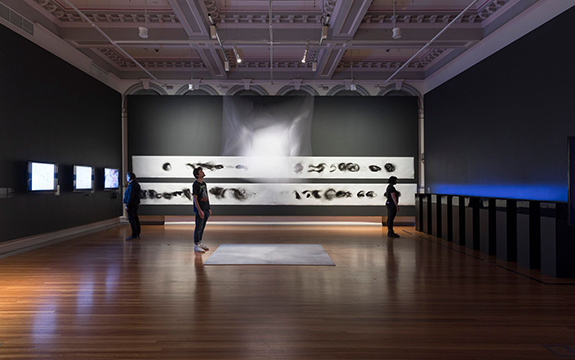 Dynamics of Air exhibition with John Sadar and Gyungju Chyon’s, 10 Kinds of Fog on the right, photography by Mark Ashkanazy.
Dynamics of Air exhibition with John Sadar and Gyungju Chyon’s, 10 Kinds of Fog on the right, photography by Mark Ashkanazy.
“The main job of architecture is to modulate air. By encouraging an experiential approach to design and architecture that opens our minds to this idea, we can raise awareness of air without being preachy or threatening with issues of climate change and energy use,” says Professor Burry.
John Sadar and Gyungju Chyon’s, 10 Kinds of Fog, explores how the depthless, formless phenomena of fog assumes different and distinct qualities. Through its form and inner structure, fog takes on different textures, weights, and movements: it can be wispy and buoyant, heavy and slithering; it can be bouncy, turbid, and tempestuous, or calm, eerie, contemplative, and still.
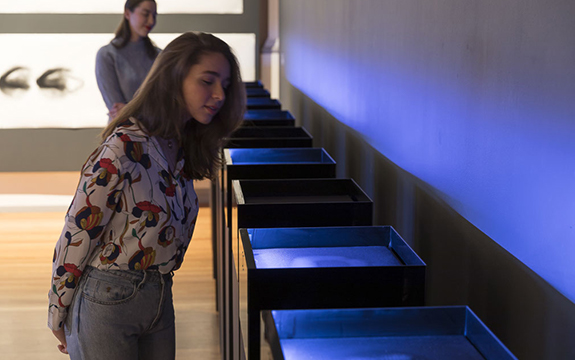 Exhibition visitors with 10 Kinds of Fog by John Sadar and Gyungju Chyon, photography by Mark Ashkanazy.
Exhibition visitors with 10 Kinds of Fog by John Sadar and Gyungju Chyon, photography by Mark Ashkanazy.
Mernoush Latifi’s, Make the Invisible Visible, displays techniques for real-time visualisation of microclimates and airflow around surfaces. The design of ceramic tiles with unique 3D shapes is based on airflow analysis. For real time visualisation of microclimates around the tiles, a mixed reality app was developed to visualise data sets from the embedded grid of sensors behind and in front of the tiles.
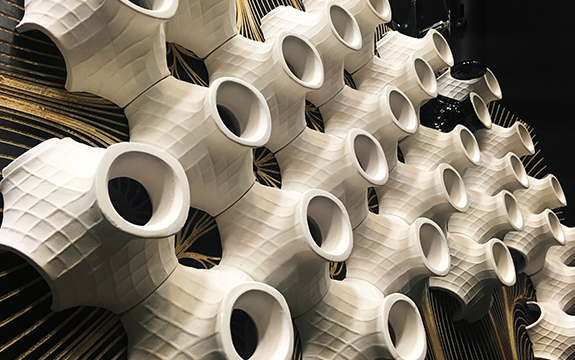 3D slipcast hollow ceramic wall tile system for passive cooling of buildings by Mehrnoush Latifi.
3D slipcast hollow ceramic wall tile system for passive cooling of buildings by Mehrnoush Latifi.
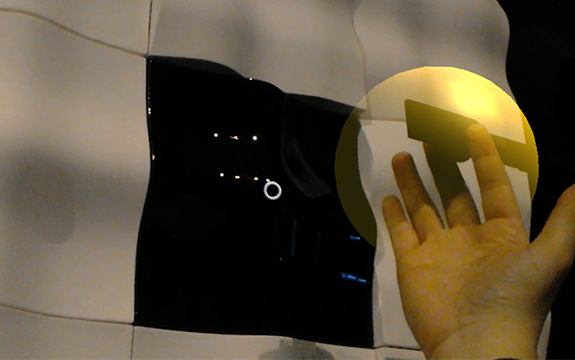 Augmented reality reveals the thermal behaviour of the tiled wall by Mehrnoush Latifi.
Augmented reality reveals the thermal behaviour of the tiled wall by Mehrnoush Latifi.
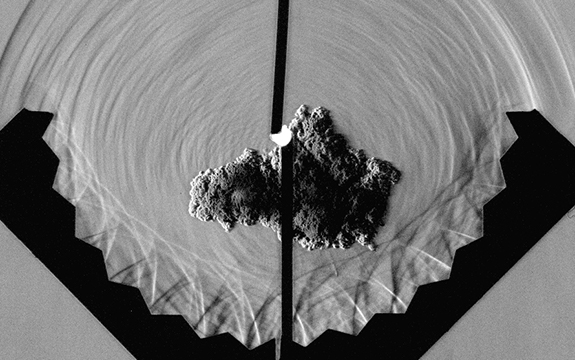 Schlieren Photography used to observe disturbances in air caused by textured surface by Mehrnoush Latifi with Phred Petersen.
Schlieren Photography used to observe disturbances in air caused by textured surface by Mehrnoush Latifi with Phred Petersen.
Daniel Prohasky’s Mini Interactive Wind Tunnel 2018 shows interactive computer simulations of wind and ways to incorporate wind data into design processes. Wind was visualised through animated colours and virtual smoke. (Technical collaborators Marcus Cher, Rafael Moya Castro and Akira Ode-Smith)
Prohasky’s Pulsometer 2018 (pulsatile airflow generator) generates continuous (sinusoidal) pulses of airflow and the frequency of pulse is communicated through the equivalent colours of the visible light spectrum. (Technical collaborators – Professoe Jane Burry and Simon Watkins)
Professor Burry’s, Air 2018 documents atmosphere in literature, philosophy and poetry in the early 19th Century. It includes statements from Wordsworth, the first poet to think and write about atmosphere and Mervyn Peake’s Gormeghast and The Great Smog of London published in the early 1950s. Literary atmospheres enter the conceptual and phenomenal lexicon in the late enlightenment with Luke Howard’s naming of clouds and the poetry of Wordsworth as “the pneumatic investigator who had gone furthest in his investigation of aerial poetics.” (Thomas H Ford, Wordsworth and the Poetics of Air) This series starts to dissolve the words into the variously charged atmospheres that the named authors have penned into existence and into readers’ sensory experience.
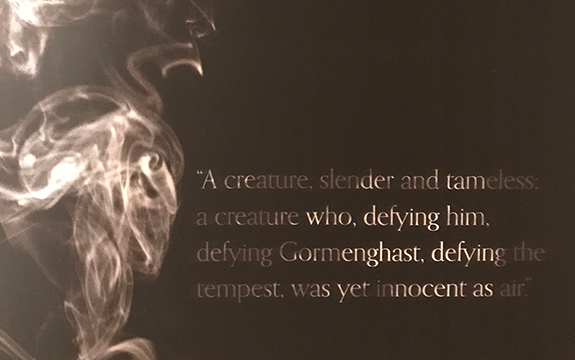 Air 2018 by Jane Burry (with Swinburne Bureau).
Air 2018 by Jane Burry (with Swinburne Bureau).
The Dynamics of Air exhibition was a major exhibition held at RMIT Gallery in partnership with the Goethe-Institut.
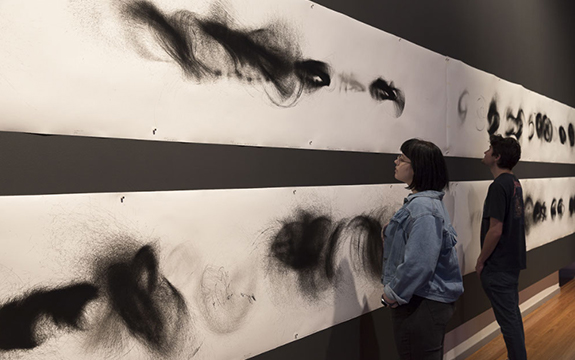 Wind drawings by Cameron Robbins, drawn by a wind powered mechanical instrument, photography by Mark Ashkanazy.
Wind drawings by Cameron Robbins, drawn by a wind powered mechanical instrument, photography by Mark Ashkanazy.
 Climatic installation by Breathe Earth Collective investigates evaporation and conditioning of air with natural essences, photography by Mark Ashkanazy.
Climatic installation by Breathe Earth Collective investigates evaporation and conditioning of air with natural essences, photography by Mark Ashkanazy.

